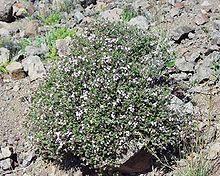Thymus vulgaris
| Thymus vulgaris | |
|---|---|

| |
| Scientific classification | |
| Kingdom: | Plantae |
| Clade: | Tracheophytes |
| Clade: | Angiosperms |
| Clade: | Eudicots |
| Clade: | Asterids |
| Order: | Lamiales |
| Family: | Lamiaceae |
| Genus: | Thymus |
| Species: | T. vulgaris
|
| Binomial name | |
| Thymus vulgaris | |

Thymus vulgaris (common thyme, German thyme,
It is useful in the garden as groundcover, where it can be short-lived, but is easily propagated from cuttings.[3] It is also the main source of thyme as an ingredient in cooking and as a herbal medicine. It is slightly spicier than oregano and sweeter than sage.
Castelltallat
)The Latin specific epithet vulgaris means “common” in the sense of “widespread”.[4]
Cultivars
Numerous
cultivars and hybrids have been developed for ornamental purposes. Nomenclature can be very confusing.[5]
French, German and English varieties vary by leaf shape and colour and essential oils.[6]
The many cultivars include 'Argenteus' (silver thyme).[7]
The cultivar 'Silver Queen', with white-margined leaves, has gained the Royal Horticultural Society's Award of Garden Merit.[8][9]
See also
References
- ^ "Bonnie Plants Thyme". Retrieved January 10, 2015.
- ^ USDA, NRCS (n.d.). "Thymus vulgaris". The PLANTS Database (plants.usda.gov). Greensboro, North Carolina: National Plant Data Team. Retrieved 10 December 2015.
- ^ ISBN 978-1405332965.
- ISBN 978-1845337315.
- ^ Totally Thyme
- ^ Herbs 2000: Thymus vulgaris
- ^ Thymus argenteus
- ^ "RHS Plant Selector - Thymus 'Silver Queen'". RHS. Retrieved 5 March 2021.
- ^ "AGM Plants - Ornamental" (PDF). Royal Horticultural Society. July 2017. p. 102. Retrieved 23 December 2018.
Bibliography
- L. H. Bailey; Manual of Cultivated Plants.
- M. Easter; International Thymus Register and Checklist.
External links

